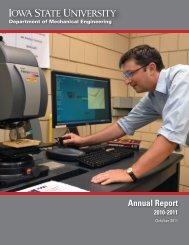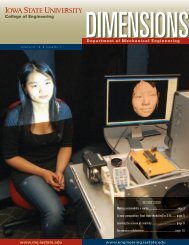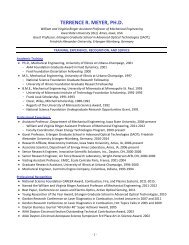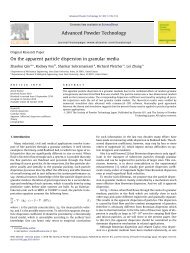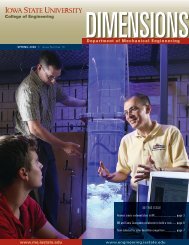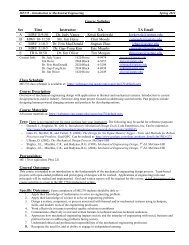Consider-then-Choose Models in Decision-Based Design ...
Consider-then-Choose Models in Decision-Based Design ...
Consider-then-Choose Models in Decision-Based Design ...
Create successful ePaper yourself
Turn your PDF publications into a flip-book with our unique Google optimized e-Paper software.
trivial KKT po<strong>in</strong>t and fails to converge at roughly the same rate<br />
as SNOPT applied to Eqn. (??). Future work will deal with these<br />
issues to achieve more robust solution of the MPCC relaxations.<br />
The Bi-Level NLP Approach<br />
Feasibility of an assumed collection of consideration sets<br />
is the first problem that must be addressed <strong>in</strong> consider<strong>in</strong>g solution<br />
of Eqn. (20) us<strong>in</strong>g the bi-level constra<strong>in</strong>ed NLP approach.<br />
In this specific case, feasibility can be determ<strong>in</strong>ed algorithmically<br />
through a l<strong>in</strong>ear feasibility problem: Because g is oneto-one<br />
over the doma<strong>in</strong> of feasible a (Fig. 1), a weak version<br />
of feasibility is the follow<strong>in</strong>g: there exists (p,g), p ≥ 0 and<br />
g ∈ range(g(a)) = [l,u] such that R i p+m i p G i g−B i ≤ 0 if ω i = 1,<br />
and R i p + m i p G i g − B i ≥ 0 if ω i = 0 for all i. These conditions<br />
are equivalent to the l<strong>in</strong>ear feasibility problem<br />
m<strong>in</strong>imize 0<br />
with respect to l ≤ g ≤ u, p ≥ 0<br />
( [ ) p<br />
subject to Σ A − B ≥ 0<br />
g]<br />
(22)<br />
where l = m<strong>in</strong>{range(g(a))}, u = max{range(g(a))}, Σ is the<br />
I × I diagonal matrix with diagonal entries σ i = 1 if ω i = 0<br />
and σ i = −1 if ω i = 1, and A is the I × 2 matrix with columns<br />
R = (R 1 ,...,R I ) and p G m = p G (m 1 ,...,m I ). Any good l<strong>in</strong>ear<br />
programm<strong>in</strong>g solver could be applied to identify feasibility of<br />
ω by solv<strong>in</strong>g this problem; SNOPT applies the primal simplex<br />
method for l<strong>in</strong>ear programs [34].<br />
Intelligent search techniques will ultimately require solution<br />
of Eqn. (20). Because each <strong>in</strong>dividual has a s<strong>in</strong>gle screen<strong>in</strong>g rule<br />
(R i = 1), we associate γ and ω and refer only to ω below. If a<br />
feasible po<strong>in</strong>t for Eqn. (22) cannot be found (and thus Eqn. (20)<br />
is <strong>in</strong>feasible), we set π ∗ (ω) = −∞. If, on the other hand, ω is<br />
such that Eqn. (20) is feasible, we estimate π ∗ (ω) by solv<strong>in</strong>g<br />
maximize<br />
( )<br />
I<br />
∑ Pi C (w i ,a,g(a), p) (p − c(a))<br />
i=1<br />
with respect to 2.5 ≤ a ≤ 15, p ≥ 0<br />
subject to s i (a, p) ≤ 0 for all i such that ω i = 1<br />
s i (a, p) ≥ 0 for all i such that ω i = 0<br />
(23)<br />
Strictly speak<strong>in</strong>g, there is no guarantee that successful solution of<br />
Eqn. (23) gives the global maximum because Eqn. (23) is a nonl<strong>in</strong>ear<br />
program. Moreover there is no guarantee that solv<strong>in</strong>g Eqn.<br />
(23) results <strong>in</strong> a strictly choice-consistent po<strong>in</strong>t: an NLP solver<br />
could, <strong>in</strong> pr<strong>in</strong>ciple, term<strong>in</strong>ate at some (a, p) with s i (a, p) = 0 for<br />
some i with ω i = 0. If solution of Eqn. (23) is not strictly choice<br />
consistent we force the values of ω to be choice consistent at the<br />
current values of (a, p), correspond<strong>in</strong>gly re-def<strong>in</strong>e the current ω,<br />
and re-evaluate the associated profits to obta<strong>in</strong> π ∗ (ω). We do not<br />
re-solve Eqn. (23) with the modified value of ω.<br />
Evaluations of π ∗ (ω) are used to solve the upper level discrete<br />
problem<br />
maximize π ∗ (ω) with respect to ω ∈ {0,1} I .<br />
We apply a simple genetic algorithm with proportional-fitness<br />
selection, one-po<strong>in</strong>t crossover, and random s<strong>in</strong>gle-bit-flip mutation<br />
(at 75% probability). Early tests <strong>in</strong>dicated that randomly<br />
sampl<strong>in</strong>g <strong>in</strong>itial populations with a significant fraction feasible<br />
values of ω was virtually impossible to do by directly sampl<strong>in</strong>g<br />
ω from I <strong>in</strong>dependent Bernoulli distributions (with p = 1/2). Instead,<br />
we select members of a feasible <strong>in</strong>itial population by randomly<br />
draw<strong>in</strong>g an acceleration-price pair (a, p), and <strong>then</strong> lett<strong>in</strong>g<br />
the collection of consideration sets correspond<strong>in</strong>g to this pair be<br />
a member of the <strong>in</strong>itial population.<br />
Currently, we have found the comparison of this evolutionary<br />
optimization approach to the MPCC relaxation mixed. Runn<strong>in</strong>g<br />
populations with 20 collections of consideration sets for 50<br />
generations takes significantly longer than solv<strong>in</strong>g the MPCC relaxations.<br />
For example, when I = 50, runn<strong>in</strong>g 50 generations<br />
requires roughly 2.5 s, while runn<strong>in</strong>g the MPCC relaxation takes<br />
0.03 s (on average). However, the full run of the evolutionary algorithm<br />
is virtually assured to f<strong>in</strong>d the global optimum, while<br />
comput<strong>in</strong>g the global optimum us<strong>in</strong>g the MPCC relaxation is<br />
likely to happen only for a small fraction of <strong>in</strong>itial conditions.<br />
Moreover the evolutionary approach often f<strong>in</strong>ds the global optimum,<br />
or at least a local optimum with similar profits, fairly<br />
quickly relative to the total time required to run all 50 generations.<br />
Future work will <strong>in</strong>vestigate this comparison more closely,<br />
and quantify the probability of comput<strong>in</strong>g the global optimum <strong>in</strong><br />
a given amount of time us<strong>in</strong>g evolutionary strategies and MPCC<br />
relaxation with multistart.<br />
7 CONCLUSIONS<br />
This article has <strong>in</strong>troduced consider-<strong>then</strong>-choose models,<br />
and extension of DCA to <strong>in</strong>clude non-smooth compensatory decision<br />
processes, to eng<strong>in</strong>eer<strong>in</strong>g design optimization. Includ<strong>in</strong>g<br />
such models is justified by a simple vehicle design example <strong>in</strong><br />
which ignor<strong>in</strong>g consideration behavior leads to sub-optimal designs.<br />
To support further research <strong>in</strong> this area, we have undertaken<br />
an <strong>in</strong>vestigation of numerical methods suitable to a general<br />
formulation of optimization with consideration def<strong>in</strong>ed by conjunctive<br />
screen<strong>in</strong>g rules. Two methods are discussed: a discrete<br />
optimization approach and a novel MPCC relaxation. Different<br />
methods for solv<strong>in</strong>g the MPCC relaxation are tested on two problem<br />
types to exam<strong>in</strong>e convergence behavior. Future work will<br />
take several directions <strong>in</strong>clud<strong>in</strong>g coupl<strong>in</strong>g of the MPCC relax-<br />
12 Copyright c○ 2012 by ASME




